Teaching English vocabulary to young learners through total physical response method
This study attempts to investigate the effect of the Total
Physical Response (TPR) Method on vocabulary retention and
explore the young learners’ attitudes toward it. It involved sixty-two
English young learners (YLs) aging from 10 to 11. All of them were
attending English classes at Viet Uc English Language Center
(VUC) in Bien Hoa City where the current study was conducted.
Both quantitative and qualitative data was obtained through the three
instruments, namely pre-and post-test and interview. Descriptive
statistics was employed for data analysis. The results revealed that
TPR affected the YLs’ vocabulary knowledge through an increase
in their vocabulary retention after they underwent the treatment.
Similarly, the findings of the study also revealed that the YLs had
positive attitudes toward the use TPR in vocabulary teaching and
learning. This study is expected to shed light on the implementation
of teaching vocabulary methods in the VUC context and other
similar contexts.
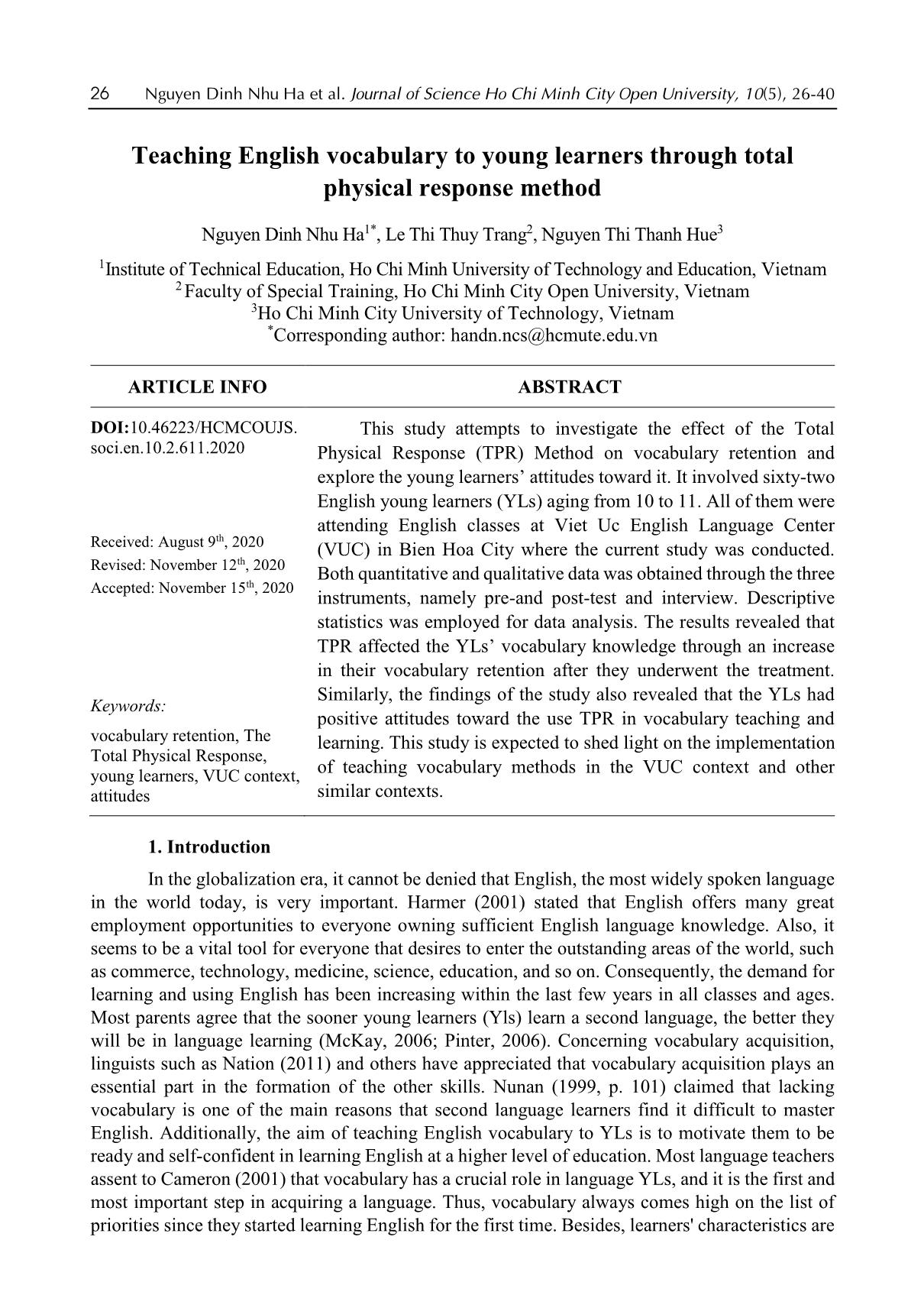
Trang 1
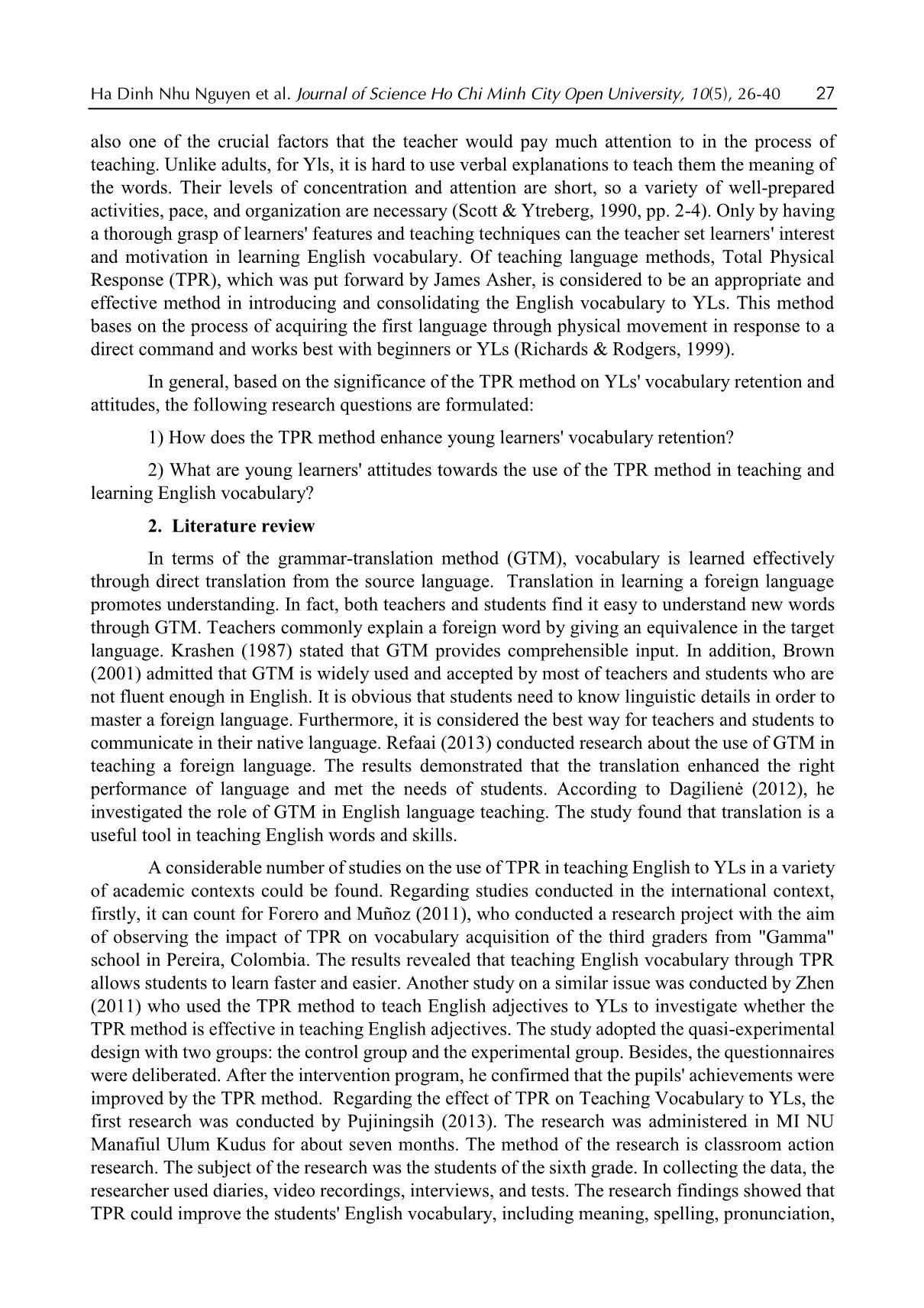
Trang 2
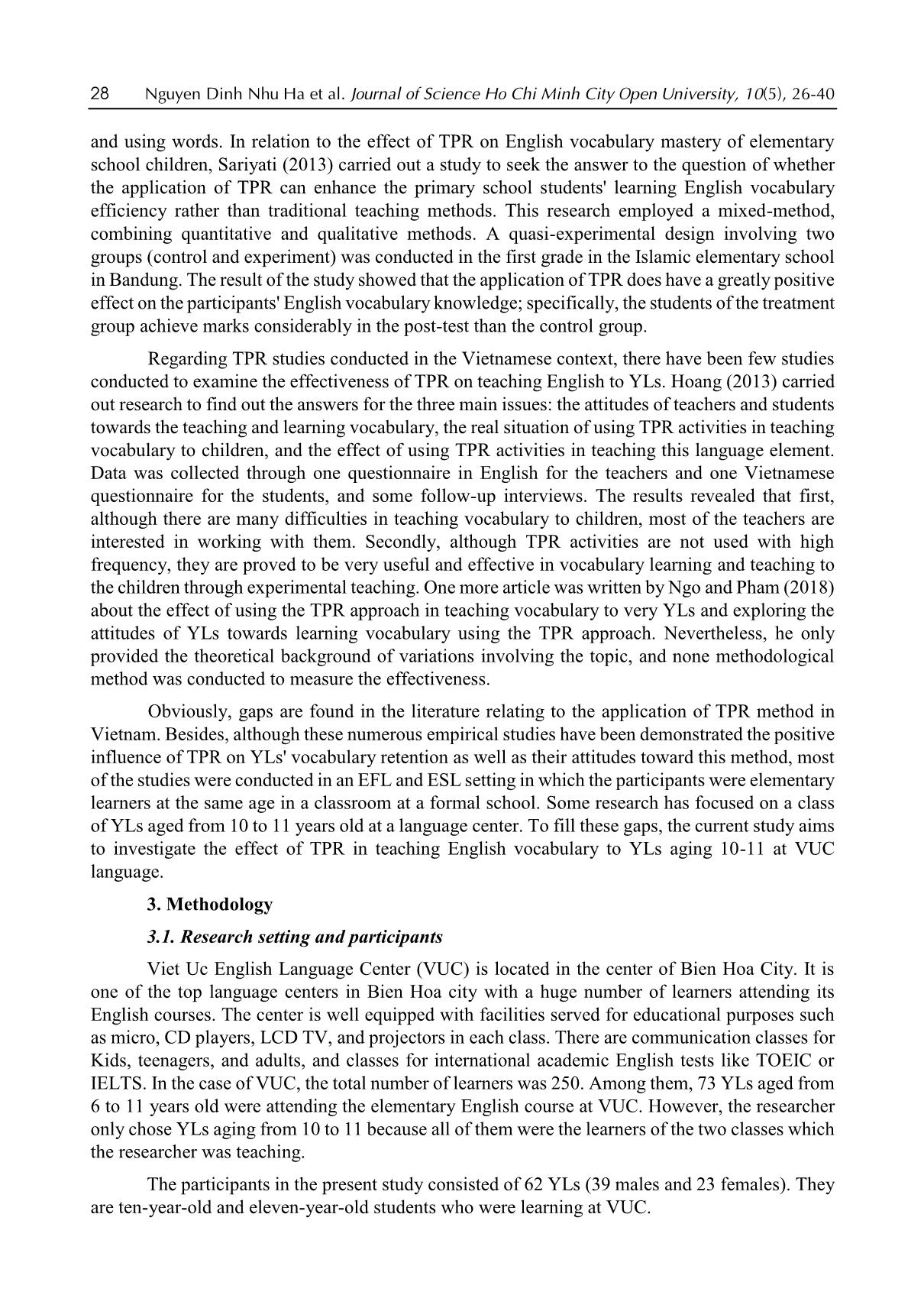
Trang 3
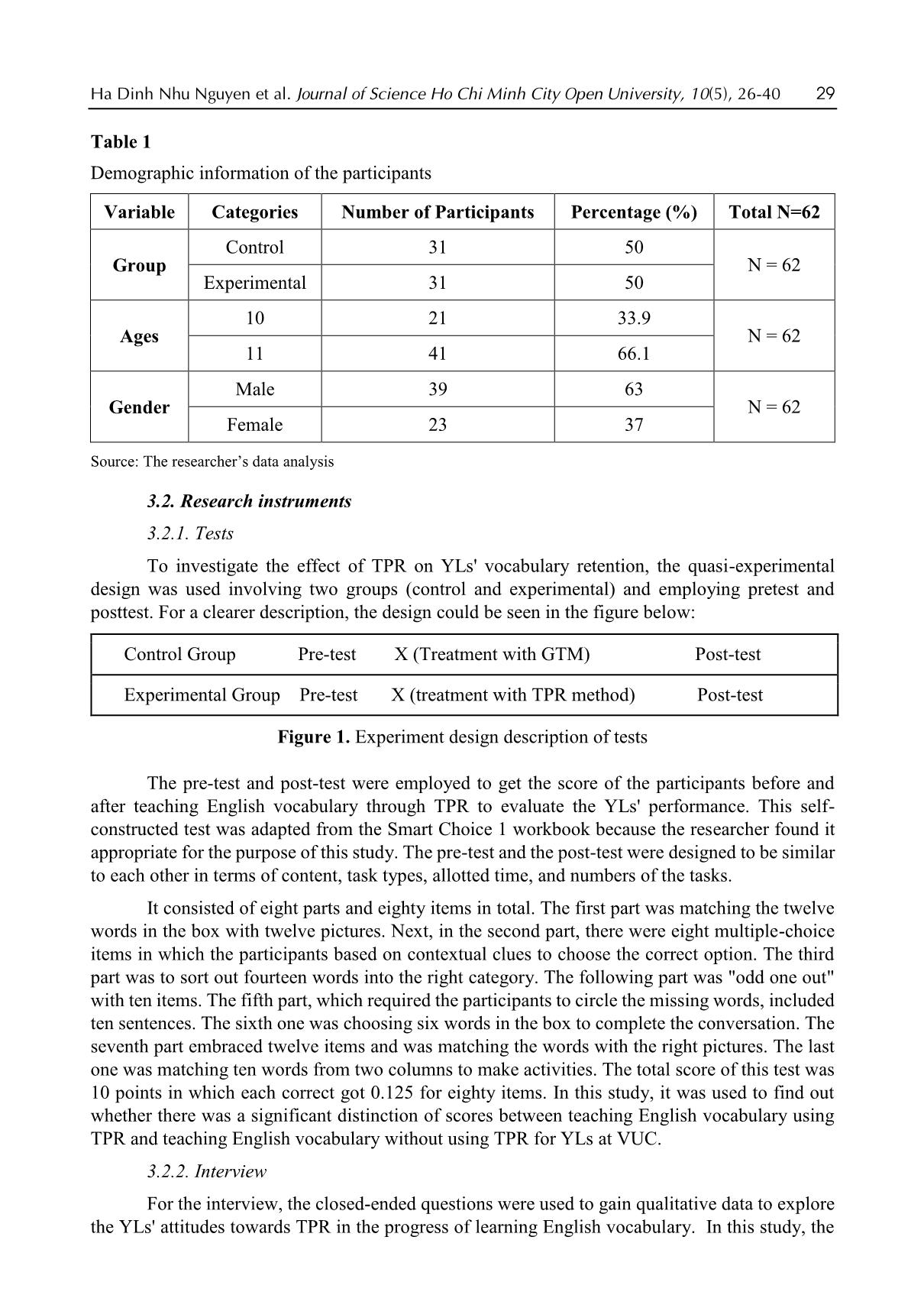
Trang 4
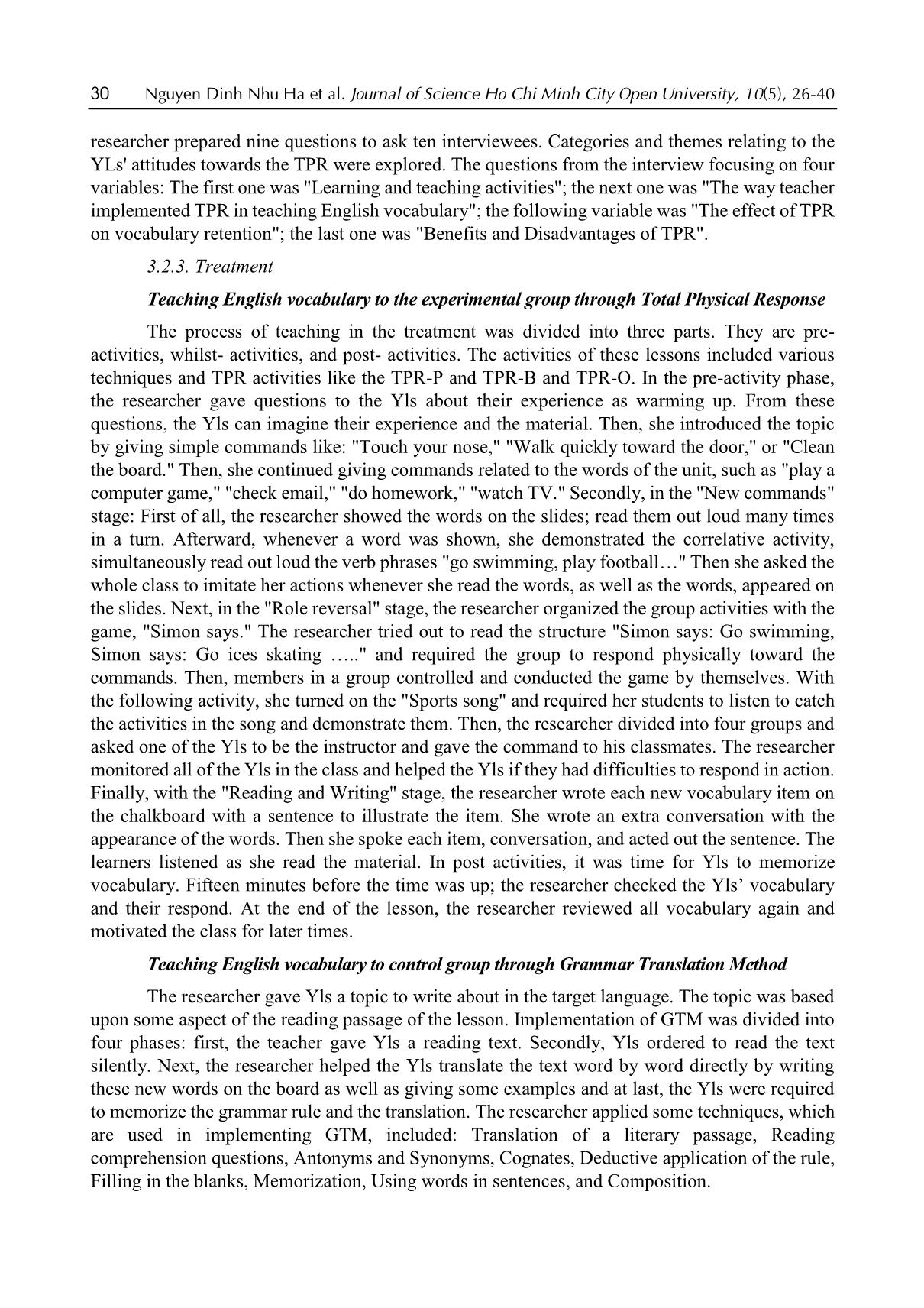
Trang 5
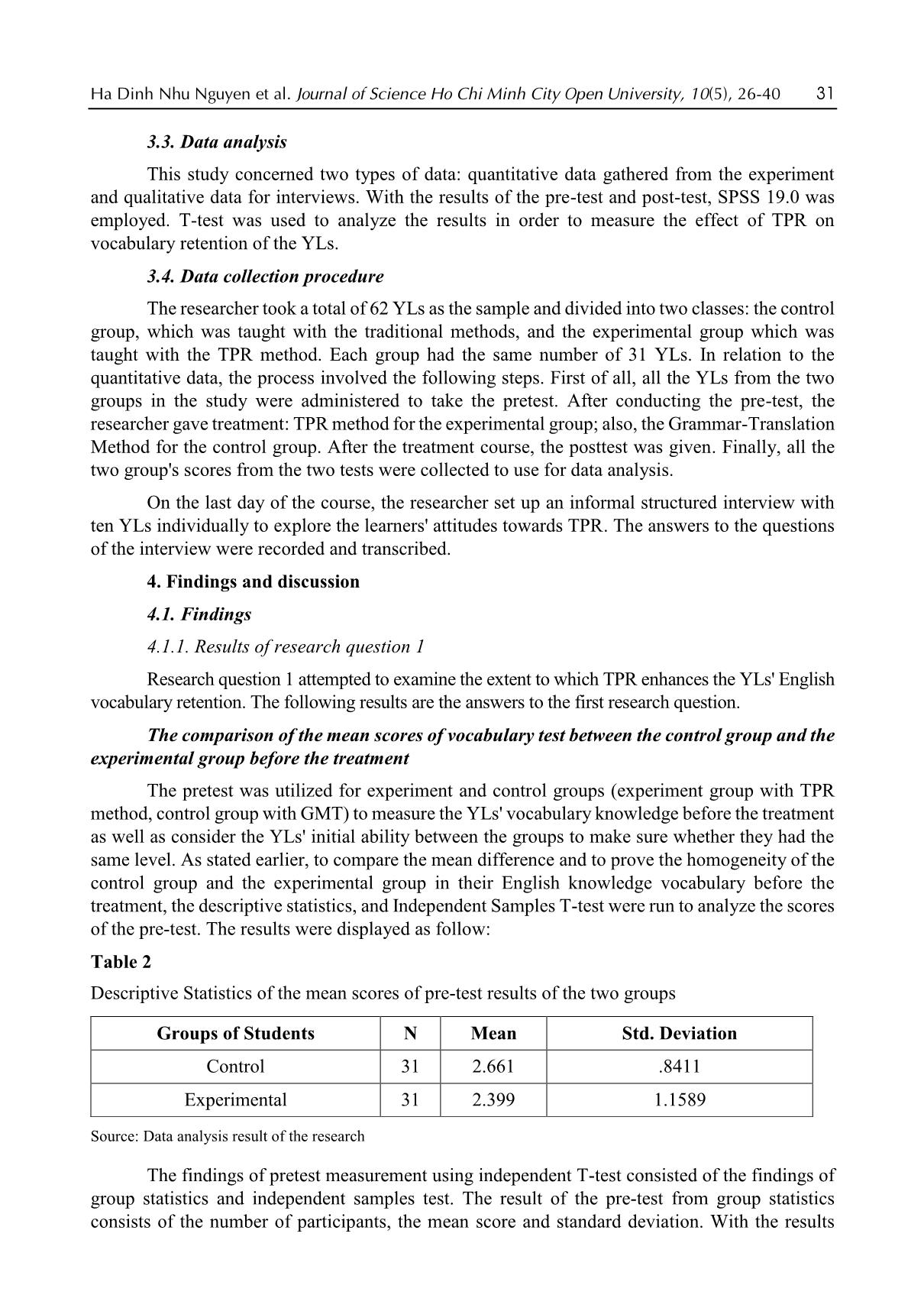
Trang 6
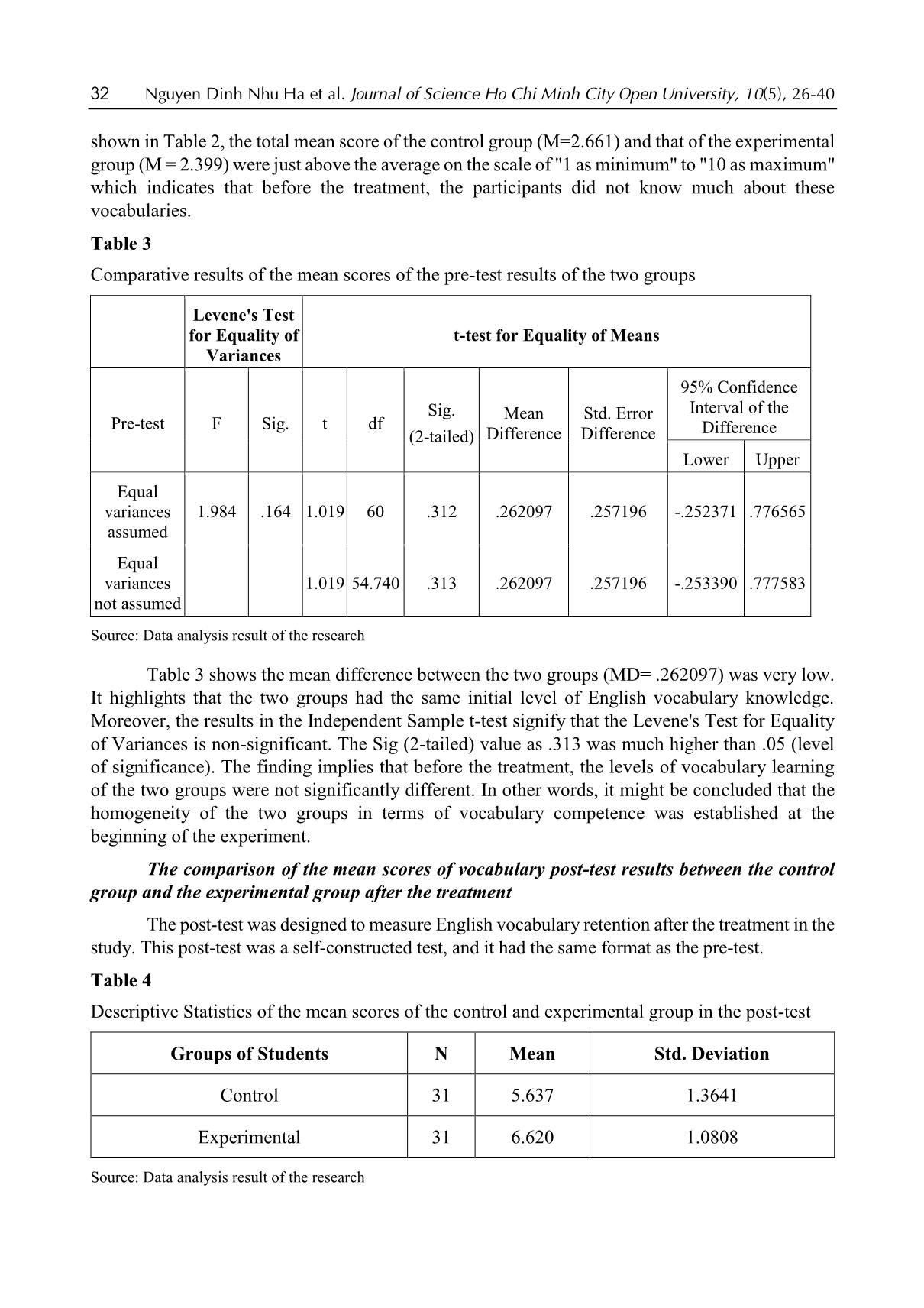
Trang 7
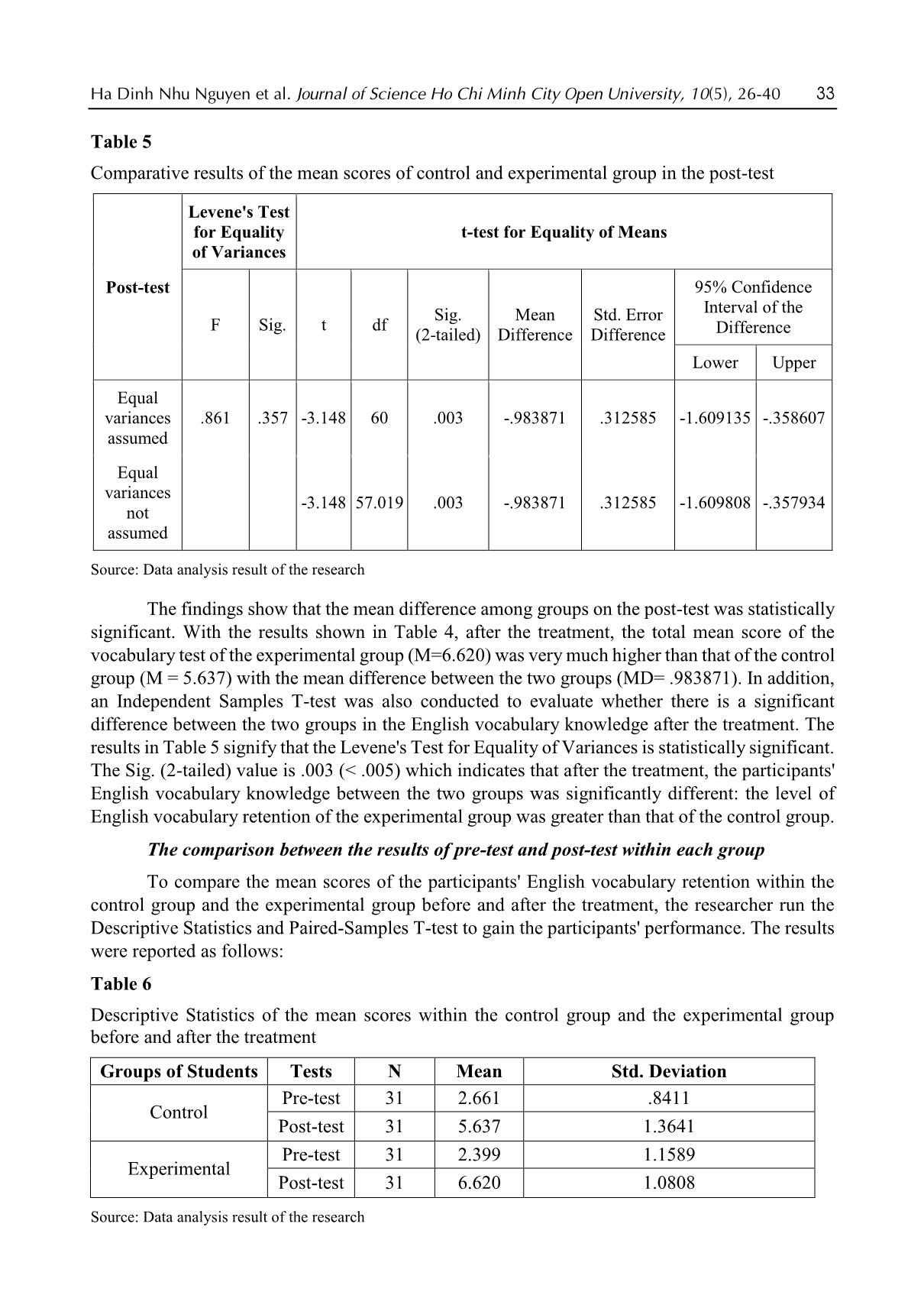
Trang 8
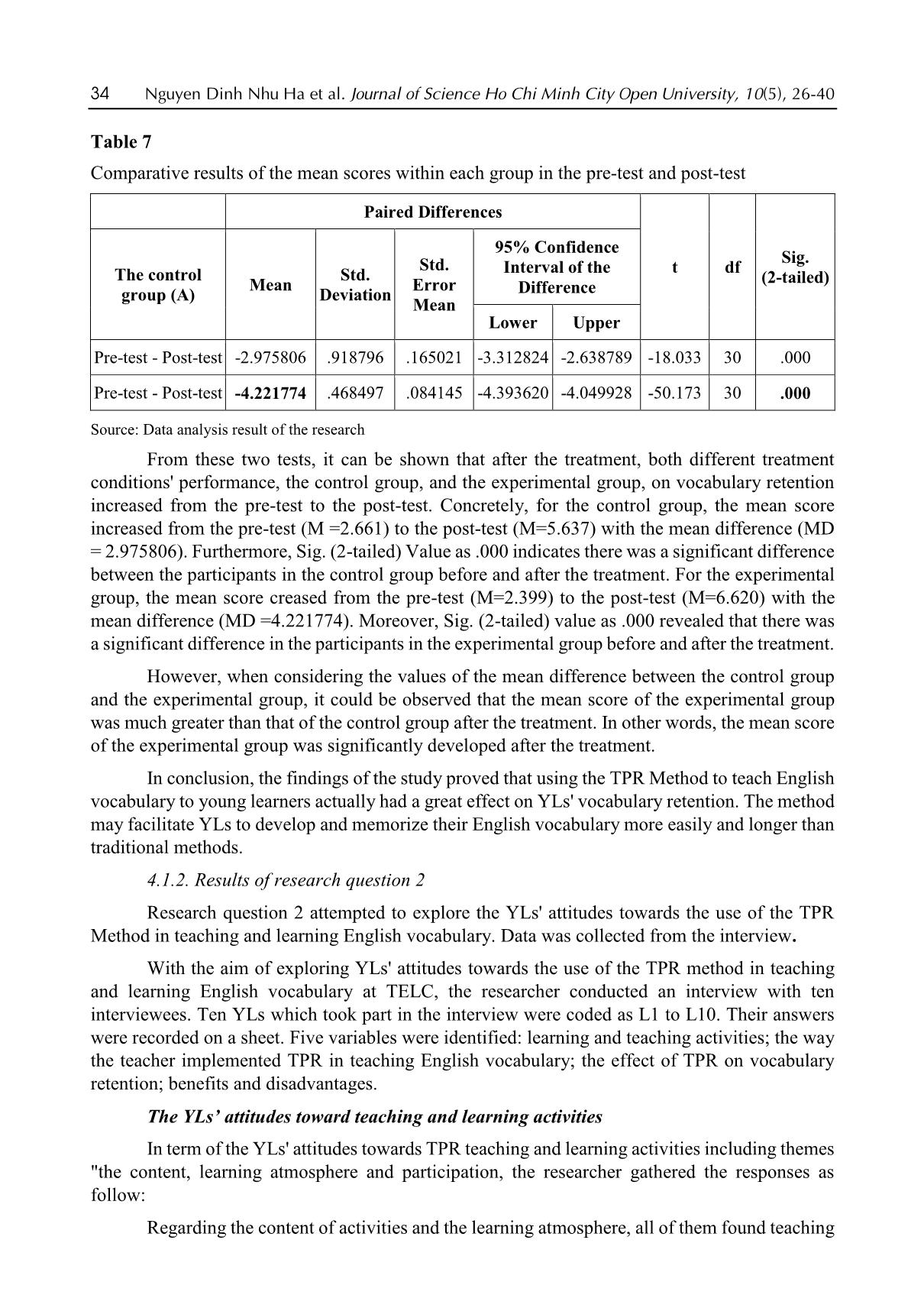
Trang 9
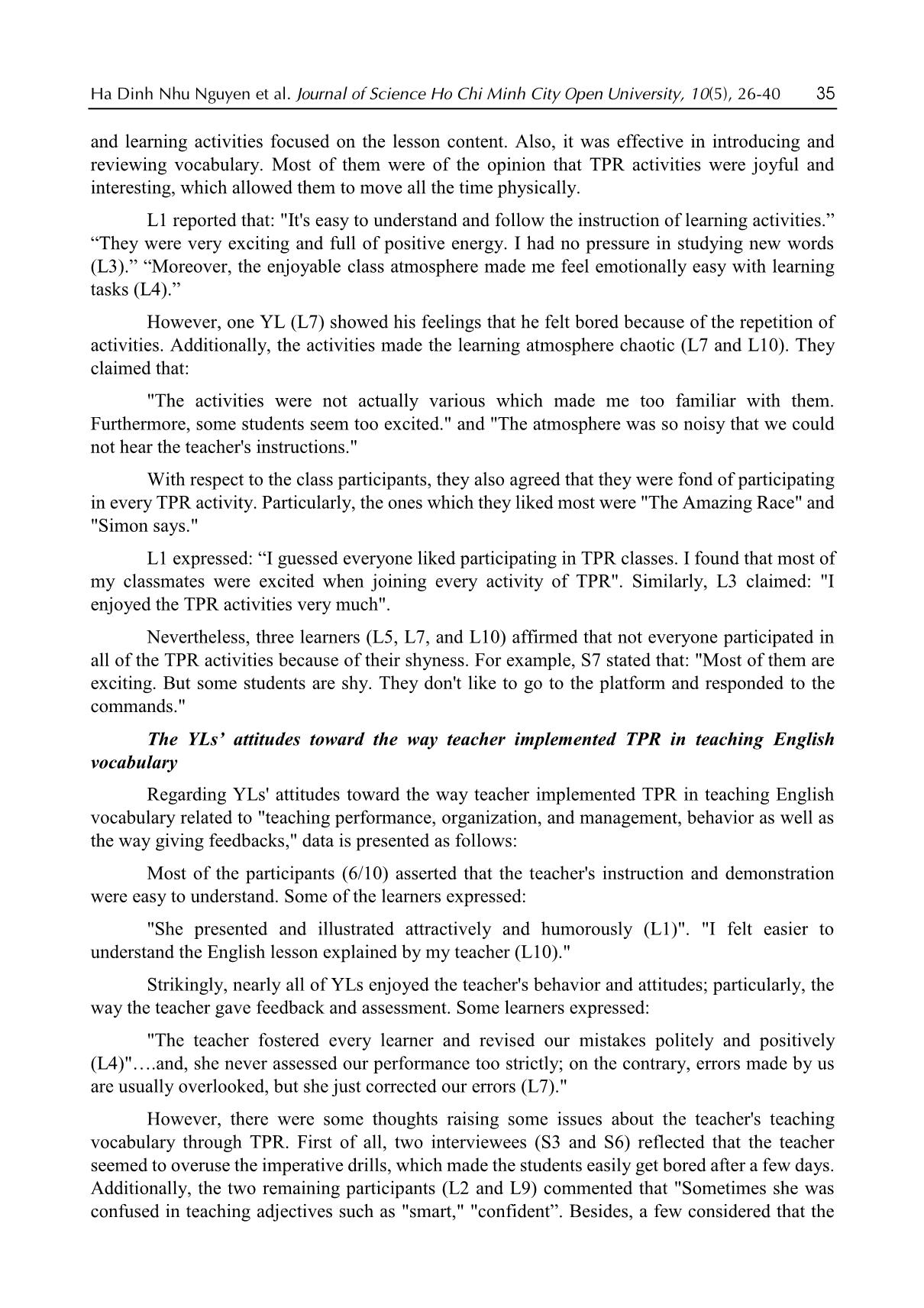
Trang 10
Tải về để xem bản đầy đủ
Tóm tắt nội dung tài liệu: Teaching English vocabulary to young learners through total physical response method
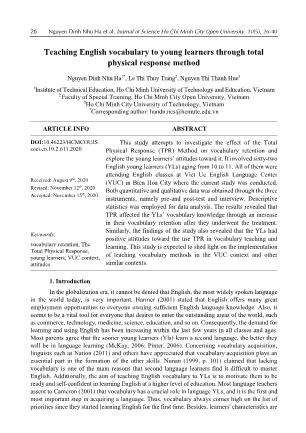
it created a fun, easy, and memorable learning atmosphere and activities. L9 reported: "We are interested in physical movements, imitation, songs, etc. And TPR has all techniques, which always make me excited". L3 asserted: "This method created a positive and lively atmosphere in the class." One learner (L1) was in favor of the procedure of TPR which was fairly simple, suitable, and easy to follow. Moreover, TPR facilitates them to understand the target language without translation to the mother tongue. However, with the last question “Did you meet any difficulties in learning English vocabulary through TPR? What limitations of TPR you think need to change or improve?” They Ha Dinh Nhu Nguyen et al. Journal of Science Ho Chi Minh City Open University, 10(5), 26-40 37 also shared some disadvantages of TPR which they experienced. As mentioned above in previous aspects, L2 and L3 complained to the researcher about "overusing TPR," which causes learners to bored. "TPR procedure utilized too many imperative drills, which made me feel overloaded sometimes (L9)." Moreover, L4 reflected: "This method is not really creative. I do not have any opportunities to express my thoughts." 4.2. Discussion 4.2.1. The effect of the TPR method on the young learners’ vocabulary retention The results of the present study seem to be satisfactorily consistent with the above- mentioned theories. First of all, the finding supports the theory of learning of TPR. It can be said that the participants in the experimental group recalled the words more effectively because they follow children's naturalistic process of absorbing the native language. Particularly, TPR mimics the process of first language acquisition, which is applied in second language teaching and learning. TPR respects the brain lateralization involving the brain hemispheres' functions: listening comprehension before verbal production. Similarly, Peck (2001, p. 143) remarked that "YLs seem to learn a language quickly when there is a combination of brain and body." The final one which the researcher recognizes as a crucial factor is the reduction of stress which is stated that the fewer stress learners endure better learning results they have (Richard & Rodgers, 1999). Secondly, the current result is in agreement with the way young learners learn foreign/second language which the researcher had discussed in the literature review. As Scott and Ytreberg (1990, p.2) emphasized that "Young learners' understanding comes from hands and eyes and ears, and the physical world is dominant at all times." Last but not least, the finding corroborates the ideas of Harmer (2007, p. 84), who suggested that the learners should be encouraged to use their own thoughts and experiences to respond to texts and situations, rather than just giving answers and learning theoretically. It indicates that it will be easy for the learners to acquire and remember the words for long-term retention if they combine their body in learning vocabulary. That is the reason why TPR helps the YLs understand and remember vocabulary for long-term retention effectively. On the other hand, GMT is a teaching foreign language method which focuses on the development of students' appreciation of the target language literature and teaching the language. Translation and reading comprehension is the main concern. In GMT, with vocabulary teaching activities, the teacher writes the words on the board and translates them directly into the native language. The learners are passive during the learning process, which makes learners bored and forget the material easily. They are also not interested in the learning process. This condition is not relevant to the characteristics of young learners. They seem attracted to experiences than learning theories. In addition, they are fond of learning by practicing it or actively take part in the learning process. After considering the characteristics of those methods, it might be concluded that TPR can bring a better result to students' vocabulary retention. The findings of the present study are consistent with Forero and Muñoz (2011), who conducted the research project to observe the impact of TPR on vocabulary knowledge of third graders from "Gamma" school in Pereira, Colombia. The results obtained revealed that teaching English vocabulary through TPR allows students to learn faster and easier. Also, the result from the research of Pujiningsih (2013) gave the consistent result that TPR enhanced YLs vocabulary acquisition. Also, the result was in accordance with the findings of the previous study of Ghani and Hanim (2014) which identified that TPR was suitable and meaningful for teaching English 38 Nguyen Dinh Nhu Ha et al. Journal of Science Ho Chi Minh City Open University, 10(5), 26-40 vocabulary to children at early stages of the learning process. Furthermore, the result is in line with that of the previous studies of Octaviany (2007), Sari (2015) and Qiu (2016). 4.2.2. The young learners’ attitudes towards the use of TPR With respect to the YLs' attitudes towards TPR, upon analyzing the results from the responses of the interview, it became evident that the YLs had positive attitudes towards the use of TPR. They reported in the affective reaction interview that they felt "interested," "enthusiastic," and "joyful" at higher frequencies than emotions such as "bored," and "shy." Furthermore, the YLs were all in accordance with many of the positive statements in the interview regarding nearly every aspect of TPR on learning vocabulary including learning and teaching activities. In general, the YLs were eager to join class activity which was a considerable sign of the effectiveness of TPR. One possible explanation for this may be because of the increased level of YLs motivation in the experimental group in vocabulary learning. Supporting this view was Lightbown and Spada (1999), the two researchers claimed that high motivation could gain language learners' enthusiasm and get their positive mood to learn the second language. TPR brought YLs an interesting experience in their vocabulary learning. Being provided the learning atmosphere full of physical movement, which is different from the traditional methods like Grammar Translation, the YLs seemed to be motivated and pay more interest in learning vocabulary. The TPR activities attract learners' interest, intrinsic motivation, and enhance enjoyment in learning. They were designed to be funny, meaningful, and learner-centered, which gave the YLs an active role in participation; hence, their motivation increased. These findings support the claims made by Hoang (2013), who conducted a study to find out the answers for the attitudes of teachers and students towards the teaching and learning vocabulary through TPR. It has been found that a stress-free environment allows children to be more receptive and motivated to learn the language. However, the results reveal that noisy, cluttered learning atmosphere sometimes, the repetitive learning activities and the overused imperative drills made YLs boring and dissatisfied. Furthermore, some opinions were shown that because of its principal using the imperative, it is of limited utility to the learner. More considerably, the findings in terms of the disadvantages of TPR collected from responses of the interview in this study mirror those found in the previous research of Hoang (2013) and Ummah (2017). It can be explained that the disadvantage of TPR is that the imperative and responses do not support learners' real-life environment. It leaves out the form of narrative, description, and conversation (Tomscha, 1986). Besides, despite the fact that most of YLs agreed that their teachers' teaching methods, behavior as well as the way giving feedbacks did have a positive effect on their learning; some of her shortcomings were reflected such as: overusing the imperative drills, confusingly teaching some items, organizing and managing as well as assessing the students' performance. All issues which were raised related to the lack of experience of the teacher in organization and management. Moreover, although the teacher herself perceived that she clearly understood the principles of TPR, it does not mean that she used TPR in the right way. 5. Conclusion and implications The results of this study have indicated that YLs' vocabulary retention could be enhanced by TPR. It was proven by the better performance in the post-test of the experiment group in comparison with the control group. In other words, after treated with TPR, the YLs' vocabulary retention has been improved. Hopefully speaking, they will gain more confidence in learning Ha Dinh Nhu Nguyen et al. Journal of Science Ho Chi Minh City Open University, 10(5), 26-40 39 English at a higher level of education thanks to TPR method. Moreover, the participants who are treated with TPR also had positive attitudes towards the use of TPR in learning English vocabulary. The findings suggest several courses of action for EFL teachers and young English learners. For the EFL teachers, they should spend time to investigate the principles, benefits, and disadvantages of TPR in teaching vocabulary so that they can apply this method appropriately and effectively in their teaching process. To implement the TPR Method successfully, EFL teachers should prepare their lessons carefully before going to class. TPR should not be used for teaching vocabulary in isolation. Teachers should use this method in enhancing language skills such as listening, speaking and writing. Through the practice of skills, YLs may learn and memorize vocabulary better. To the English young learners, they should be encouraged to take part in activities during the lesson. They should concentrate on activities or assignments provided by the teachers so that they can acquire the language more easily under the guidance of the teachers. However, the study was limited in several ways. First of all, the time of conducting the training experiment in this study was limited. This research was conducted within only a month, which means in total in four weeks. Therefore, if the study would be conducted for a longer time, it would be desirable to yield more generalizable findings. The second limitation lies within the teachers' practice, perception, and own approach in teaching the English Language. That is to say, not all the activities relating to TPR were taught during the treatment. Finally, the participants were only 62 YLs in only one site of study so the findings may not be generalizable to other sites. Tài liệu tham khảo Brown, H. D. (2001). Teaching by principle. An interactive approach to language pedagogy. New York, NY: Person Education. Cameron, L. (2001). Teaching languages to young learners. Cambridge, UK: Cambridge University Press. Dagilienė, I. (2012). Translation as a learning method in English language teaching. Studies about Languages, 2012(21), 124-129. Forero, M. A. V., & Muñoz, M. E. M. (2011). Teaching English vocabulary to third graders through the application of the Total Physical Response method. (Unpublished master’s thesis). Universidad Technological De Pereira, Risaralda, Colombia. Ghani, M. Z., & Hanim, N. H. (2014). The effectiveness of total physical response (TPR) approach in helping slow young learners with low achievement acquire English as a second language. International Journal of Research in Social Sciences, 4(6), 156-169. Harmer, J. (2001). The practice of English language teaching. Essex, UK: Pearson Education Ltd. Harmer, J. (2007). How to teach English. Essex, UK: Pearson Education Ltd. Hoang, D. T. K. (2013). Suggested total physical response activities to teach English vocabulary. (Unpublished master’s thesis). Vinh University, Vietnam. Krashen, S. (1987). Principles and practice in second language acquisition. London, UK: Prentice Hall International. Lightbown, P. M., & Spada. N. (1999). How languages are learned. Oxford, UK: Oxford University Press. 40 Nguyen Dinh Nhu Ha et al. Journal of Science Ho Chi Minh City Open University, 10(5), 26-40 McKay, P. (2006). Assessing young language learners. Cambridge, UK: Cambridge University Press. Nation, P. (2011). Teaching and learning vocabulary. New York, NY: Newbury House. Ngo, A. T. C., & Pham, H. V. P. (2018). The effect of using Total Physical Response on EFL YLs’ vocabulary and speaking fluency. Retrieved June 15, 2020, from https://www.researchgate.net/publication Nunan, D. (1999). Second language teaching & learning. Boston, MA: Heinle & Heinle publishers. Octaviany, Y. (2007). The application of total physical response in teaching English vocabulary to the fourth graders. (Unpublished bachelor degree of education thesis), State University of Semarang, Indonesia. Peck, S. (2001). Teaching English as a second or foreign language. Boston, MA: Heinle Cengage Learning. Pinter, A. (2006). Teaching young language learners. Oxford, UK: Oxford University Press. Pujiningsih, N. (2013). Improving students’ English vocabulary by using total physical response. (Unpublished doctoral dissertation). Sebelas Maret University, Indonesia. Qiu, Y. (2016). Research on the application of total physical response approach to vocabulary teaching in primary schools. International Journal of Arts and Commerce, 5(7), 18-24. Refaai, K. I. (2013). Suggested guidelines for using translation in foreign language learning and teaching. International Research Journals, 4(1), 12-20. Richards, J., & Rodgers, T. (1999). Approaches and methods in language teaching. Cambridge, UK: Cambridge University Press Sari, D. M. (2015). The implementation of teaching English vocabulary using Total Physical Response at the fifth grade. (Unpublished bachelor degree of education thesis). Universitas Muhammadiyah Surakarta, Indonesia. Sariyati, I. (2013). The effectiveness of TPR method in English vocabulary mastery of elementary school children. PAROLE: Journal of Linguistics and Education, 3(1), 50-64. Scott, W. A., & Ytreberg, L. H. (1990). Teaching English to children. London and New York: Longman. Tomscha, T. (1986). Using TPR communicatively. Paper presented at the Annual Conference of the International Association of Teachers of English for Foreign Language, Brighton, England. Ummah, S. S. (2017). The implementation of TPR (Total Physical Response) method in teaching English for early childhood. Advances in Social Science, Education and Humanities Research (ASSEHR), 58, 421-428. Zhen, Y. (2011). Using TPR method in teaching English adjectives. (Unpublished doctoral dissertation). Kristianstad University, Sweden.
File đính kèm:
 teaching_english_vocabulary_to_young_learners_through_total.pdf
teaching_english_vocabulary_to_young_learners_through_total.pdf

